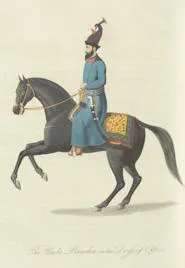
The plate shown here is from a first edition of Mountstuart Elphinstone’s Account of the kingdom of Caubul … (1815) which provides a rich account of the Durrani Empire in the early 19th century, with striking hand-coloured illustrations.
Using Library Search
The Marsden Collection is mostly catalogued and records are available through King's Library Search.
Being signed in to Library Search gives the best functionality for searching and the homepage gives advice on how to narrow down your searches by using scopes and by filtering searches you have made. For full instructions please see both the Library Search homepage and also our 'Catalogues' webpage, available by scrolling down to the menu on the Special Collections homepage.
Using scopes
You can limit your search to Foyle Special Collections Library items by using scopes.
If you select the ‘Library Resources’ scope, only the print and ebooks, audiovisual material and journals held by the campus libraries and Foyle Special Collections Library will be retrieved in your searches
Using filters
For finding material related to specific collections or former owners, use the ‘Library Resources’ scope in the drop down menu and then filter by ‘Former owner’ in the Advanced search criteria to display records from a specific collection.
You can also use the Location drop down menu on the left hand side of the screen to identify items from specific named special collections.
Please do contact us for further advice on identifying material which will assist you with your studies.
Related resources
A collection of Marsden’s manuscripts are held in the College Archives In 1918 about a third of the collection was transferred to other parts of the University of London (SOAS for material in oriental languages and SSEES for material in Slavonic languages).
Bibliography and further reading
John Bastin. The British in West Sumatra (1685-1825): a selection of documents, mainly from the East India Company records preserved in the India Office Library, Commonwealth Relations Office, London. Kuala Lumpur: University of Malaya Press, 1965 [Maughan Library, Humanities books DS646.1 B29]
Andrew S. Cook. ‘Marsden, William (1754-1836)’, Oxford Dictionary of National Biography, Oxford University Press, 2004 [http://www.oxforddnb.com/view/article/18102, accessed 9 Sept 2013]
William Marsden. Bibliotheca Marsdeniana philologica et orientalis: a catalogue of books and manuscripts collected with a view to the general comparison of languages, and to the study of Oriental literature. London: Printed by J. L. Cox, 1827 [Foyle Special Collections Library, Special Collections Ref. Z7050.M36]
William Marsden. A brief memoir of the life and writings of the late William Marsden written by himself, with notes from his correspondence [edited by Elizabeth W Marsden]. London: Printed by J. L. Cox and Sons, 1838 [Foyle Special Collections Library, Special Collections Ref. Z989 M3]
William Marsden. The history of Sumatra. Oxford: Oxford University Press, 1986 [Maughan Library, LGF Humanities Books Store, DS646.129 MAR] A facsimile of the third edition of this work which was originally published in London by McCreery in 1811, with introduction by John Bastin.
Eames, Wilberforce. The discovery of a lost Cambridge imprint John Eliot's Genesis, 1655: being a note communicated in his behalf to the Annual Meeting of the Colonial Society of Massachusetts November 22, 1937. Boston: DB Updike, The Merrymount Press, [1937] [Foyle Special Collections Library, College History Collection BS1234.A4.E4 EAM]